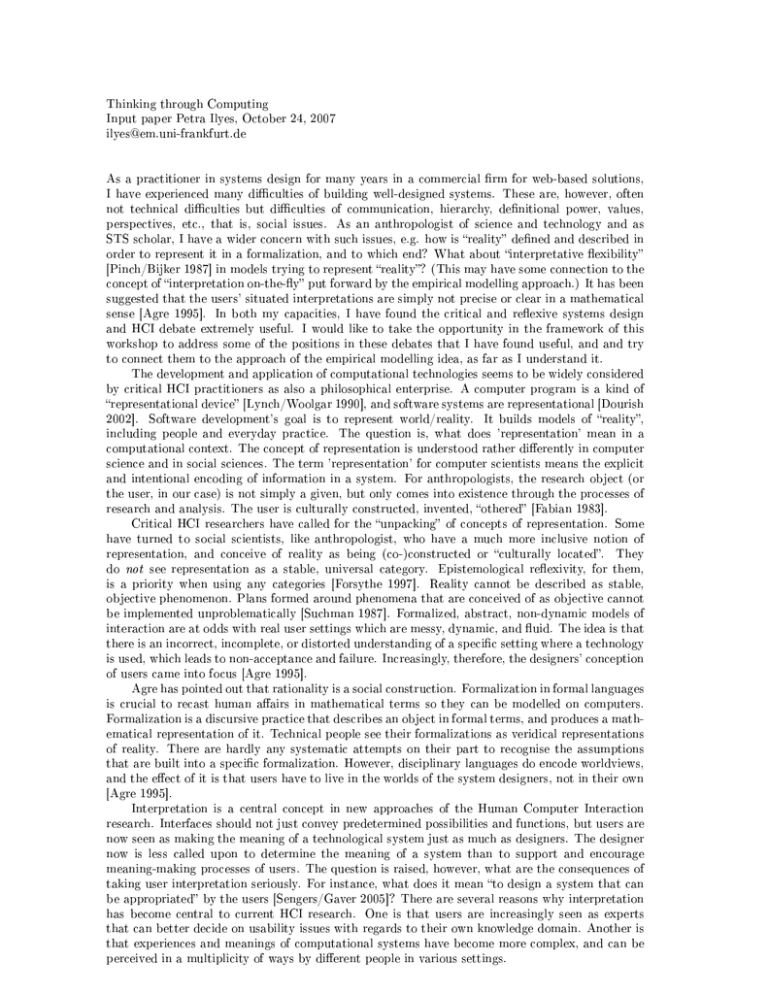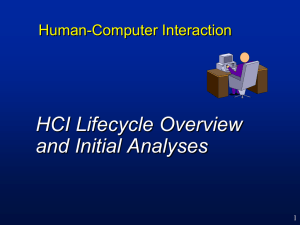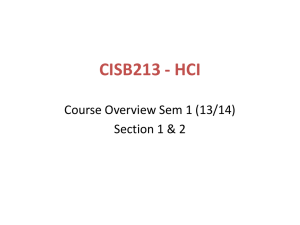Thinking through Computing Input paper Petra Ilyes, October 24, 2007 -frankfurt.de
advertisement

Thinking through Computing Input paper Petra Ilyes, October 24, 2007 ilyes@em.uni-frankfurt.de As a practitioner in systems design for many years in a commercial rm for web-based solutions, I have experienced many diculties of building well-designed systems. These are, however, often not technical diculties but diculties of communication, hierarchy, denitional power, values, perspectives, etc., that is, social issues. As an anthropologist of science and technology and as STS scholar, I have a wider concern with such issues, e.g. how is reality dened and described in order to represent it in a formalization, and to which end? What about interpretative exibility [Pinch/Bijker 1987] in models trying to represent reality? (This may have some connection to the concept of interpretation on-the-y put forward by the empirical modelling approach.) It has been suggested that the users' situated interpretations are simply not precise or clear in a mathematical sense [Agre 1995]. In both my capacities, I have found the critical and reexive systems design and HCI debate extremely useful. I would like to take the opportunity in the framework of this workshop to address some of the positions in these debates that I have found useful, and and try to connect them to the approach of the empirical modelling idea, as far as I understand it. The development and application of computational technologies seems to be widely considered by critical HCI practitioners as also a philosophical enterprise. A computer program is a kind of representational device [Lynch/Woolgar 1990], and software systems are representational [Dourish 2002]. Software development's goal is to represent world/reality. It builds models of reality, including people and everyday practice. The question is, what does 'representation' mean in a computational context. The concept of representation is understood rather dierently in computer science and in social sciences. The term 'representation' for computer scientists means the explicit and intentional encoding of information in a system. For anthropologists, the research object (or the user, in our case) is not simply a given, but only comes into existence through the processes of research and analysis. The user is culturally constructed, invented, othered [Fabian 1983]. Critical HCI researchers have called for the unpacking of concepts of representation. Some have turned to social scientists, like anthropologist, who have a much more inclusive notion of representation, and conceive of reality as being (co-)constructed or culturally located. They do not see representation as a stable, universal category. Epistemological reexivity, for them, is a priority when using any categories [Forsythe 1997]. Reality cannot be described as stable, objective phenomenon. Plans formed around phenomena that are conceived of as objective cannot be implemented unproblematically [Suchman 1987]. Formalized, abstract, non-dynamic models of interaction are at odds with real user settings which are messy, dynamic, and uid. The idea is that there is an incorrect, incomplete, or distorted understanding of a specic setting where a technology is used, which leads to non-acceptance and failure. Increasingly, therefore, the designers' conception of users came into focus [Agre 1995]. Agre has pointed out that rationality is a social construction. Formalization in formal languages is crucial to recast human aairs in mathematical terms so they can be modelled on computers. Formalization is a discursive practice that describes an object in formal terms, and produces a mathematical representation of it. Technical people see their formalizations as veridical representations of reality. There are hardly any systematic attempts on their part to recognise the assumptions that are built into a specic formalization. However, disciplinary languages do encode worldviews, and the eect of it is that users have to live in the worlds of the system designers, not in their own [Agre 1995]. Interpretation is a central concept in new approaches of the Human Computer Interaction research. Interfaces should not just convey predetermined possibilities and functions, but users are now seen as making the meaning of a technological system just as much as designers. The designer now is less called upon to determine the meaning of a system than to support and encourage meaning-making processes of users. The question is raised, however, what are the consequences of taking user interpretation seriously. For instance, what does it mean to design a system that can be appropriated by the users [Sengers/Gaver 2005]? There are several reasons why interpretation has become central to current HCI research. One is that users are increasingly seen as experts that can better decide on usability issues with regards to their own knowledge domain. Another is that experiences and meanings of computational systems have become more complex, and can be perceived in a multiplicity of ways by dierent people in various settings. Recently, HCI pracitioners have started to discuss critical and reective design approaches that put claims to an emancipatory quality of HCI's orientation to design. How does a critical stance aect the practice of HCI, what is the relationship between theory and practice in reective HCI, and how does the role of the users change [Sengers/McCarthy/Dourish 2006]? The question of humanities computing, as problematised in Beynon/Russ [2006], concerns the concept of modelbuilding. It emphasises exploration and negotiation of meaning through experience [152f.]. This seems to be not so far away from critical approaches in HCI. The point I want to make, however, is that the idea of a better modelling of reality must be preceded by a rigorous deconstruction of what the categories of modelling, reality, meaning, representation, etc., mean, that is, reect built-in assumptions and cultural values, and acknowledge the social construction and interpretive exibility of categories. I would also like to ask how one can possibly describe a reality as stable that really is highly dynamic and constantly changing. Isn't that kind of description necessarily a prescription? That is, the implementation of such a static description or prescription will necessarily lead to a dysfunctional system because it cannot change. References Agre, Philip E. (1995) Conceptions of the user in computer systems design. In: Thomas, Peter J. (ed.) The Social and Interactional Dimensions of Human-Computer Interfaces. Cambridge University Press, Cambridge, USA, pp.67-106. Beynon, Meurig/Steve Russ (2006) Human Computing Modelling with Meaning. Literary and Linguistic Computing. Vol. 21, No. 2, 2006, pp.141-157. Dourish, Paul (2002) What We Talk About When We Talk About Context. Personal and Ubiquitous Computing, Volume 8, Number 1, February 2004, pp.19-30(12). Fabian, Johannes (1983) Time and the Other. How Anthropology makes its Object. Columbia University Press, New York. Forsythe, Diana (1997) Representing the User in Software Design. http://www.stanford.edu/ dept/HPS/forsythe.paper.html (last accessed: October 2007). Lynch, Michael/Steve Woolgar (1990) Introduction: Sociological Orientation to Representational Practice in Science. In: Lynch, Michael/Steve Woolgar (eds.) Representation in Scientic Practice. MIT Press, Cambridge, USA, pp.1-18. Pinch, Trevor J./Wiebe E. Bijker (1987) The Social Construction of Facts and Artifacts: Or How the Sociology of Science and the Sociology of Technology Might Benet Each Other. In: Bijker, Wiebe E./Thomas P. Hughes/Trevor J. Pinch (eds.) The Social Construction of Technological Systems. MIT Press, Cambridge MA, London, England, pp.17-50. Sengers, Phoebe/Bill Gaver (2005) Designing for Interpretation. Proceedings of HumanComputer Interaction International, 2005 http://cemcom.infosci.cornell.edu/papers/ sengers-gaver.design-for-interpretation.pdf (last accessed: October 2007). Sengers, Phoebe/John McCarthy/Paul Dourish (2006) Reective HCI: Articulating a Research Agenda for Critical Practice. Workshop abstract. Extended Abstracts of CHI 2006. http://cemcom.infosci.cornell.edu/uploads/pubs/Reflective%20HCI: %20Articulating%20a%20Research%20Agenda%20for%20Critical%20Practice..pdf. (last accessed: October 2007). Suchman, Lucy (1987) Plans and Situated Action: The Problem of Human-Machine Communication. Cambridge University Press, Cambridge, USA.







